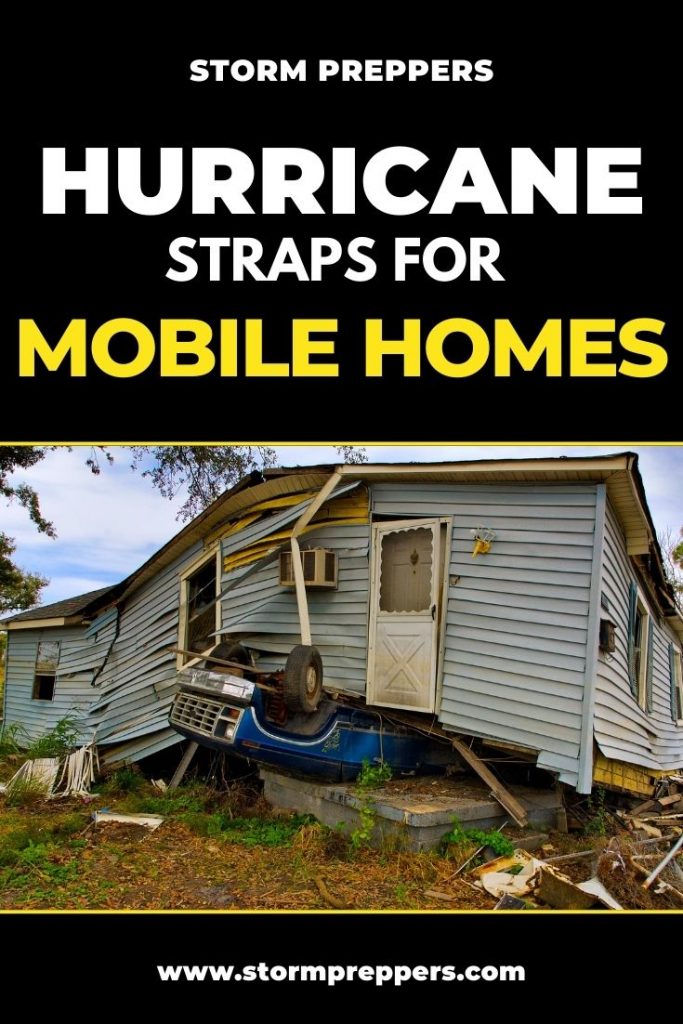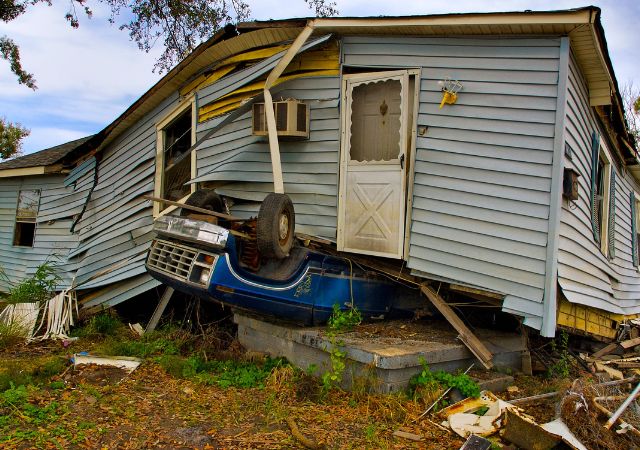Please Note: If you live in a mobile home and a tropical storm is threatening your area and you are advised to evacuate, please do so. Do not ride out the storm in your mobile home. Although you may have installed specific hurricane straps for mobile homes, most of these types of homes do not have any safe rooms that you can seek shelter in.
When a dangerous tropical storm is threatening your area, there are a few choices that you can make. You can choose to stay and ride out the storm in your home, seek shelter in a hurricane shelter or evacuate to an area that is out of the path of the storm. If you live in a mobile home, and you choose to stay, you must secure the home to the best of your ability. Although it may be difficult with short notice, one of the options for securing the home is to purchase and install hurricane straps for mobile homes.
In recent years, many homeowners have benefitted from hurricane straps on their homes. Hurricane straps are often used to reinforce roofs to prevent them from flying off during high winds. If you are interested in securing your mobile property with hurricane straps, pay close attention to the tie-down requirements, types of tie-downs, buying guides, and find out where to purchase straps.
Why Do Mobile Homes Need Hurricane Straps?
Mobile homes, which are also known as manufactured homes are extremely vulnerable to strong winds and severe weather. A strong wind can easily flip over the home, and thus cause severe damage. Over the years, there have been thousands of stories from mobile home owners whose homes sustained damage or were lost during hurricanes and thunderstorms. To withstand adverse weather conditions, homeowners can install straps or tie-downs which can help to stabilize the home.
Depending on where they are located, mobile homes are designed to be moved quickly and easily. As a result, they may be slightly elevated from the ground and rest on temporary foundation of wood or stone. Unfortunately, this makes them prone to destruction from strong winds. If mobile homes are not fixed with hurricane straps or tie-downs, they can be lifted off of their foundations with strong winds. Homeowners should ensure that their homes are secured to their foundations, which should also be anchored sturdily into the ground.
Therefore, the main benefit of straps and tie-downs is to hold these homes in place and prevent them from being uprooted during a storm.
Types of Tie Downs and Hurricane Straps for Mobile Homes
Although there are many types of hurricane tie-downs on the market, there are two types of tie-downs that are used specifically for mobiles homes. They are:
- Frame Anchors
- Over-The-Top
Frame Anchors
In older homes, some straps were installed over the frame rails of the home. However, construction practices for newer mobile homes have improved considerably and they are stronger than older mobile homes. As a result, newly constructed mobile houses can be secured only with frame anchors. It should be noted that the double-wide frame anchors provide better support and are tough enough to support the entire building without over-the-top tie-downs.
Over-The-Top
Over-the-top tie-downs are installed on the sides of the home and the roof. New construction mobile homes are outfitted with concealed over-the-top tie-downs. They are installed during construction and are used to strengthen the roof and the connectors from the roof to the walls.
Many builders prefer to use the over-the-top tie-downs, because they do not affect the aesthetics of the home. It is recommended that these types of tie-downs be added to single-width mobile houses because they are very lightweight. And, because they are lightweight, they are more vulnerable to high-speed winds, which can overturn and life the home and cause costly damage.
Tie-Down Requirements for Mobile Homes
Different types of mobile homes have different tie-down requirements. These requirements are dependent on two critical factors:
- Length of the home: The number of tie-downs required depends on the length of the house
- Location of the home: The location is also important that determines the number of tie-downs you would need
If you live in a coastal area or close to a coastal area, you will need more tie-downs and straps to safeguard the home and prevent it from overturning. This is because wind speeds tend to be higher and more destructive in and near the coastal areas.
To prevent mobile homes from overturning, engineers use two types of tie-downs. One is a diagonal strap, and the other is a vertical strap. Diagonal straps prevent the house from overturning, while the vertical straps are installed over the roof to prevent wind damage.
How to Install Hurricane Straps on Mobile Homes
Any project to install hurricane straps on mobile homes, should be carried out in calm and sunny weather conditions. There are four main steps that should be followed when straps are being installed on a home:
- Figure out Which Tie-Down to Use
- Choose the Right Anchors
- Determine How Many Tie-Downs to Use
- Install the Straps
Step 1: Figure out Which Tie-Down to Use
If you have an older mobile home, you should install the over-the-top tie-downs. This will make it more secure against high winds. Most newer homes come with pre-installed over-the-top straps. If your home is not equipped with straps, you should consider installing them at some point.
Step 2: Choose the Right Anchors
When you are choosing anchors for your home, you may comes across several options. The type of hurricane anchor that you will need, depends on the area in which you live. The three types of anchors are:
- Auger Anchors
- Hard Rock Anchors
- Drive Anchors
Auger anchors can be used in both soft and hard soils. They are made of pure steel and come with a set of threads that are screwed deep into the ground. Hard rock anchors, which are also known as solid rock anchors, are used to secure homes that sit on hard rock foundations. Drive anchors are used when the the home has a concrete foundation. Drive anchors are similar to auger anchors, however, they are specifically designed to pierce through concrete.
Step 3: Determine How Many Tie-Downs to Use
Although it may seem that the more straps on the home, the more secure it is, this does not apply to mobile homes. There is a minimum strap count that is required to secure your mobile home. The specific number of straps required will be in the users’ manual! Alternatively, you can obtain the services of a professional, who can advise you of the number of straps and the types of straps that must be bought.
Step 4: Install the Straps
The fourth and final step is the installation of the mobile home tie-downs. The installation procedure consists of several tasks which are outlined below:
- Ensure the home is at the proper level;
- Take a marker and mark all the power lines, sewer pipes, cables and other home fittings that you do not want to install the straps over;
- Position the tie-downs in the right spot. If you are going with over-the-top tie-downs, these should be installed on your roof rafter (if you have it pre-installed, simply skip it);
- Secure the anchors with the designated fasteners;
- Adjust the tie-downs if the fit is not quite right. Try not to make one side tighter than the other side. If you do this, you are doing it incorrectly and the straps will fail. The aim is to gradually adjust both sides in a side-to-side manner and tighten them.
What to Look For When Inspecting Hurricane Straps and Tie Downs
As a mobile homeowner, you should conduct regular inspections before, during and after the hurricane season. When inspecting your mobile home, there are a few things that you should look at:
- Soil and climatic conditions around and under the home
- The foundation – soil, concrete, or hard rock
- Piers and stilts that the home is resting on
- Level of elevation and whether it can withstand flooding
- Grading and skirting
- Method of anchoring and spacing between anchors
- Corrosion of fittings and fasteners
- Tongues and wheels
If you find anything that is out of order and in need of repairs or replacement, please get in touch with a professional as quickly as possible.
Further Reading
For more information about securing mobile homes and mobile home safety during tropical storms and hurricanes, please visit the following links:
American Red Cross North Texas Region: Mobile Home Safety in Severe Weather
Attainable Home: What Are Mobile Home Hurricane Tie-Downs (Do They Work?)
Clayton Homes: Are Manufactured Homes Safe During Storms?
US Mobile Home Pros: Mobile Home Tie Down Requirements
How to Look at a House: What are the Tie-Down Requirements for a Mobile Home?
Home Nation: How to Tie Down a Mobile Home
Mobile Home Living: Storm Safety: Preparing Your Mobile Home
Braustin Homes: Are Mobile Homes Safe in Storms? Let’s Be Honest.
25 News Now: Local Weather Experts Encourages Mobile Home Safety During Severe Storms
Image: John Middelkoop via Unsplash





